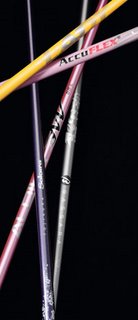 Just like there are no men driving VW Beetles with those dainty flower holders, the macho factor won't allow male golfers to play anything less than a stiff flex.
Just like there are no men driving VW Beetles with those dainty flower holders, the macho factor won't allow male golfers to play anything less than a stiff flex.However, it is important to understand just how shaft flexibility affects performance. After all, the shaft is often known as the "engine" of the golf club.
Theodore P. Jorgensen authored a book called "The Physics of Golf." He conducted several experiments to demonstrate that the shaft of the golf club during the golf swing actually bends forward at impact. Jorgensen provides a graph indicating that the clubhead lags behind the hands at the start of the downswing. However, by the time that the club is about horizontal to the ground, the clubhead catches up to the hands and eventually leads the shaft at impact.
This is counterintuitive to what most people believe. While all golfers acknowledge that the clubhead lags at the start of the downswing, most assume that it continues to lag until well after impact. Furthermore, it is commonly assumed that the more flexible the shaft, the more that the clubhead lags throughout the swing. Golfers assume these things because that's what it feels like during the swing. However, as with many things in golf, what you feel is not always what is real.
In reality, the shaft unloads during the downswing and kicks forward by impact, regardless of swing speed or shaft flex rating. Our hands simply cannot outpace the clubhead as the shaft unloads during the golf swing. In fact, the more flexible the shaft, the more that the clubhead will kick forward, increasing velocity and effective loft. Therefore, all other things being equal, softer shafts provide more distance and a higher trajectory than their stiffer siblings. This applies to all human-generated swing speeds, including that of Tiger Woods. Tiger himself acknowledges this phenomenon writing, "If I had weaker shafts I'd hit the ball farther just because there's more flex in the shaft and more kick in a regular-flex shaft than in the stiff shafts I use."
So why doesn't Tiger switch to "senior" flex shafts? While a more flexible shaft will provide more distance, the tradeoff is less control. It is simply much more difficult to control the clubface at impact with a more flexible shaft. The last thing that Tiger wants to do is to miss more fairways! For the rest of us, distance is probably our primary concern. Regardless, it is very important for us to play with the right flex for our unique swings. If you haven't done so already, I recommend that you visit your local golf retailer and receive a proper fitting. Finding the correct flex is fast, easy, and usually free.
Labels: Equipment




